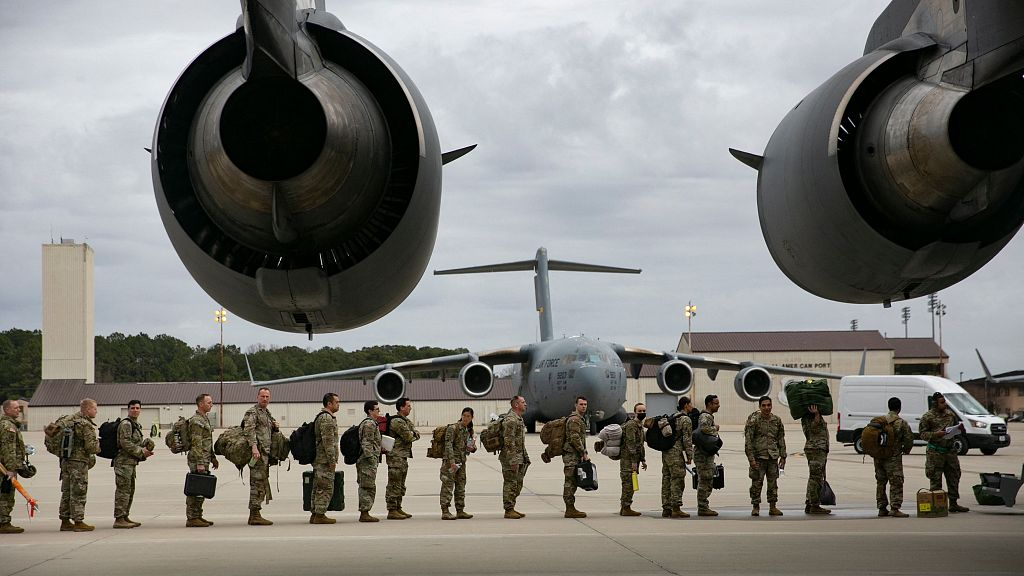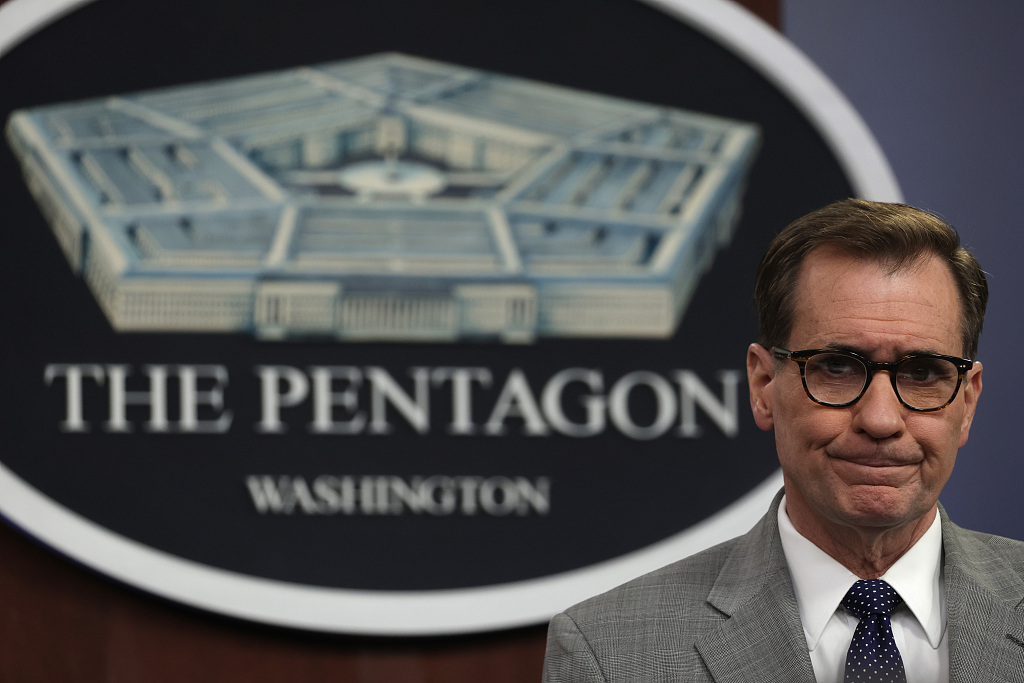
U.S. troops deploy for Europe from Pope Army Airfield at Fort Bragg, North Carolina, February 3, 2022. /CFP
U.S. troops deploy for Europe from Pope Army Airfield at Fort Bragg, North Carolina, February 3, 2022. /CFP
Editor's note: Liu Qiang is the vice chairman and director of the Academic Committee of Shanghai Center for RimPac Strategic and International Studies. The article reflects the author's opinions, and not necessarily those of CGTN.
On December 15, the U.S. Senate officially passed the National Defense Authorization Act (NDAA) for Fiscal Year 2023 (FY23), in which the most eye-catching is the military spending, $45 billion more than the budget proposed by President Joe Biden, reaching a record high of $857.9 billion, about $80 billion more than the previous fiscal year. Why did the U.S. increase its defense spending so significantly? What does it want to do? What impact will it have?
First of all, Washington intends to maintain its military strength and intensify the "great power competition." Released by the U.S. Senate in June, the FY23 NDAA Agreement Executive Summary sought additional funding to support the development of key military capabilities such as microelectronic and hypersonic technologies as well as the strategic warfighting concept "Joint All Domain Command and Control."
Six months later, the officially released FY23 NDAA basically reflects the thrust of the executive summary, focusing on the "strategic competition" between the U.S., China and Russia. As is known to all, the U.S. has been rated as one of the world's largest military powers, which has enabled itself to develop "disruptive technologies" and upgrade its equipment, in order to constantly provide assistance to Ukraine amid the conflict with Russia. Also, Washington tends to respond to the so-called ‘China threat,’ which is determined by its strategic goals of "focusing on two theaters – the Indo-Pacific and the war in Europe," according to White House Indo-Pacific policy coordinator Kurt Campbell.
Planning is of great significance for many key areas in modern warfare, including command and control, intelligence collection and distribution, intelligent equipment development, and attacks on rival platforms. This means that the U.S. needs to upgrade or even replace its existing arm forces on the pretext of coping with "great power competition," so as to form a military "generation gap" with China and Russia, which will not only play a role in strategic deterrence, but increase the probability of victory in future conflicts.
Second, the U.S. tends to set a benchmark for military growth and urge its allies to increase their corresponding expenditures. The $80 billion additional part of U.S. defense budget for 2023, compared to the last year, has already exceeded the total annual counterpart of India, the third largest military spender in the world, at $76.6 billion in 2021.
This is surprising given the numerous problems facing the U.S. economy. No wonder Stephen Semler, co-founder of U.S. independent think tank Institute for Security Policy Reform, commented that the peak of U.S. military spending during the Cold War pales in comparison to today, when politicians care more about whether the Pentagon has enough money than whether American people lead a good life.

Pentagon Press Secretary John Kirby conducts a news briefing at the Pentagon in Arlington, Virginia, after U.S. Secretary of Defense Lloyd Austin ordered 500 more U.S. service members to be deployed to locations in Europe, March 7, 2022. /CFP
Pentagon Press Secretary John Kirby conducts a news briefing at the Pentagon in Arlington, Virginia, after U.S. Secretary of Defense Lloyd Austin ordered 500 more U.S. service members to be deployed to locations in Europe, March 7, 2022. /CFP
Considering the relations between the U.S. and its allies in recent years, especially since the outbreak of the Russia-Ukraine conflict, such a large increase in the U.S. military budget is actually setting a benchmark for its allies, urging them to also significantly increase their military expenditure, in order to enhance the overall strength of the alliance and maintain a military advantage over China and Russia.
Third, Washington wants to be fully prepared to intervene in potential conflicts between other countries. Despite its claim that the nation is no longer the world's policeman, the nature of its military interventionism has not changed. In addition to talking about the "China threat," the FY23 NDAA contains important legislation related to the Taiwan region, with three important goals: to strengthen Taiwan's ability to counter attacks, to improve U.S. forces' ability to quickly come to Taiwan's aid if it were attacked, and to establish the so-called joint U.S.-Taiwan military cooperation. This is clearly a manifestation of naked military interventionism in China.
The Chinese government has expressed firm opposition and lodged stern representations with the U.S. side. Such a large increase in U.S. military expenditure, part of which will be used for military investment and support to the Taiwan region, will not help change the balance of military forces across the Taiwan Straits, but aggravate the Taiwan question. This is obviously what the U.S. government and its military-industrial complex are most satisfied about, as there are huge economic interests behind it.
In addition, the FY23 NDAA stated that the salary of both military and civilian personnel in the Department of Defense will see an increase by 4.6 percent in 2023, which is claimed to help offset the costs of higher rent and food prices. It is clear that although the income of U.S. soldiers may not be the highest in the world, it definitely belongs to the highest class. Under such circumstances, the increase in salaries is nothing more than to attract more young people to join the army, so as to ensure sufficient and quality military resources for military intervention in other major regional issues, including the Taiwan question.
Last but not least, high military expenditure has intensified the international arms race. From the perspective of balance of power theory, a substantial increase in military expenditure by the U.S. will inevitably lead to increased insecurity in relevant countries, which may also increase their military expenditures to improve security index. This will become the source of arms race and make the world enter an era of tension, exacerbating international turmoil and conflicts.
The U.S. is the world's largest arms dealer, but it is prohibited by law from selling materials related to weapons of mass destruction to other countries. This time, the U.S. is upgrading its weapons through the development of disruptive technologies, which means "destocking" many obsolete weapons. Weapons are special commodities, which can be used for defense as well as offense. The sale of these weapons to some unstable and war-torn regions will inevitably lead to increased hatred, escalation of wars and loss of life, which will lead to regional instability and further affect the change of the international security situation, and the U.S. will reap the benefits.
(If you want to contribute and have specific expertise, please contact us at opinions@cgtn.com. Follow @thouse_opinions on Twitter to discover the latest commentaries in the CGTN Opinion Section.)